Economic Report on Scottish Agriculture 2011 Edition
Invalid description field:Agriculture
This document is part of a collection
Section A: Total Income From Farming ( TIFF) Aggregate Output Values, Input Costs and Related Measures
Introduction
Headline results on Total Income From Farming ( TIFF) for 2010 were published in a Statistical Publication on 27th January 2011. This publication contains information on aggregate output values, input costs and subsidy payments that contribute to the TIFF results. This publication also contains an overview of TIFF trends since 1973, tables showing the components of TIFF for the 10 year period from 2001 to 2010 and commentary and graphics focussing on the key changes between 2009 and 2010. It also contains background information on the compilation and uses of TIFF. This publication is available at http://www.scotland.gov.uk/Publications/2011/01/27082045/0
Section A of the Economic Report on Scottish Agriculture compliments the publication above by providing:
- More detailed information on TIFF, including underlying levels of agricultural production, use of inputs and associated prices.
- Results for related economic indicators including productivity and TIFF per Annual Work Unit ( AWU).
- Aggregate balance sheet information on assets, liabilities, net worth and investment by farmers.
Some of the tables in Section A include information for the 5 year period between 2006 and 2010, with longer term trends provided in spreadsheet format on the publication web page. The focus of the commentary and graphics is for the 10 year period 2001 to 2010, with all charts and underlying data also available on the web.
The content of Section A was changed in last year's publication to include graphics and more detailed commentary. Section A has been further developed to reflect the outcome of a wider Publication Review of Agricultural Statistics. Details of this Publication Review are available on the Scotstat website and were discussed by the Agriculture Committee of stakeholders at the November 2010 meeting: http://www.scotland.gov.uk/Topics/Statistics/Browse/Agriculture-Fisheries/scotstat/AgMeetings
Key changes to Section A:
- Further increasing the amount of commentary and graphics.
- Including information on related economic indicators, investment and productivity and therefore ceasing the separate annual publication of "Scottish Agriculture Output, Input and Income Statistics".
- Removing detailed monthly price information.
- Removing regional cereal yield results.
Total Income From Farming ( TIFF) ( Table A1)
Total Income From Farming ( TIFF) represents business profit plus income to farmers, partners, directors and others with an entrepreneurial interest in the farm business.
Over the past 10 years there has been a general upward trend in TIFF, which has increased by £284 million (85%), from £334 million in 2001 to £618 million in 2010. TIFF increased by £122 million (25%) between 2009 and 2010, following decreases of £84-£85 million in each of the previous 2 years. The level of TIFF in 2010 (£618 million) was lower than the recent peak in 2007 (£665 million).
Chart A1: TIFF (at current prices) 2001 to 2010
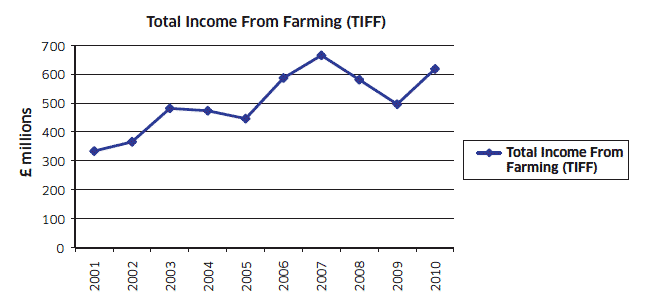
Chart A2 shows the component contribution of TIFF, with output and total payments and subsidies showing a positive contribution and input costs, other costs and consumption of fixed capital showing a negative contribution.
Chart A2: Component contribution to TIFF 2001 to 2010
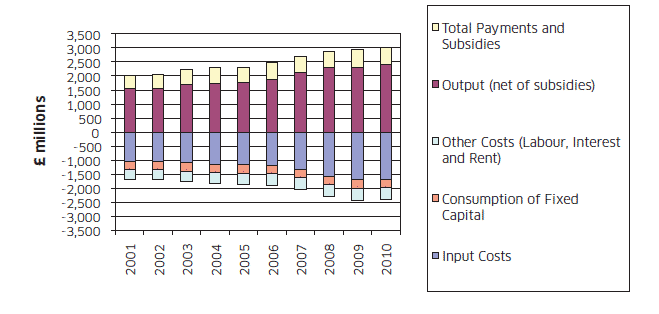
Over the past 10 years the output value from agricultural businesses has increased by £851 million (55%) and has been accompanied by an increase of £151 million (33%) in the value of payments and subsidies. Over the same period, input costs have risen by £637 million (62%) and other costs (including labour, interest payments and rent) have increased by £70 million (20%). The level of consumption of fixed capital has remained fairly constant, decreasing by £11 million (4%).
The overall value of TIFF is small in comparison to the value of outputs and input costs and is therefore quite sensitive to small percentage changes in these larger values. Between 2009 and 2010, output values (net of subsidies) increased by £110 million (4.7%) and input and other costs decreased by £47 million (2.2%). The value of total payments and subsidies decreased by £31 million (4.8%) and consumption of fixed capital increased by £6 million (1.9%). These changes result in an increase in TIFF of £122 million (25%) between 2009 and 2010.
Outputs
Over the past 10 years the total output value of crops, excluding related subsidies, has increased by £348 million (75%) to £810 million in 2010. There has been a steady increase in the value of horticulture (up £125 million or 108%) and oilseed rape and other farm crops (up £29 million or 136%), whilst the trends in cereals and potatoes have been more erratic.
Between 2001 and 2010 the value of cereals increased by £147 million (79%), however this trend includes large increases of £123 million between 2006 and 2007 and £81 million between 2009 and 2010, as well as a large decrease of £137 million between 2008 and 2009. These trends largely reflect market prices movements, as production levels have not varied to this extent.
Chart A3: Output Value of Crops (excluding subsidies) 2001 to 2010
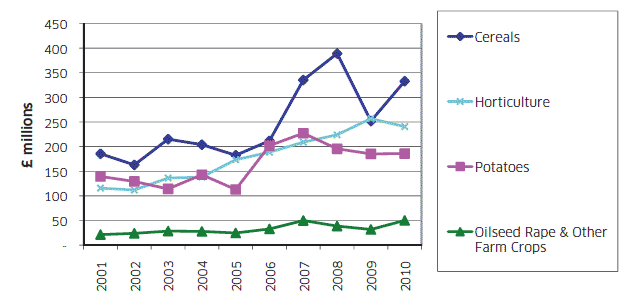
The value of potatoes increased by £46 million (33%) between 2001 and 2010. Most of this increase occurred between 2005 and 2006, when production and market prices of potatoes both increased.
Between 2009 and 2010 the output value of crops increased by £84 million (12%), mostly due to the £81 million (32%) increase in the value of cereals. The £18 million (58%) increase in oilseed rape and other farm crops was countered by the £16 million (6%) decrease in horticulture. There was little change in the value of potatoes.
The output value of crops is determined by a combination of production and market prices. The next few paragraphs consider these trends for a selection of crops.
Tables A2(i) to A2(iii) provide information on area, yield and production of a selection of crops. These production figures form the basis of TIFF crop valuations. It should be noted however that production is valued at the point it is used or sold off the farm, so there can be differences between calendar year production and output volumes. The TIFF calculation also includes end year stock valuations.
Statistics on crops areas come from the June Agricultural Census. A detailed description of area trends between 2001 and 2010 is available in the Statistical Publication dated 16th December 2010, titled 'Final Results From 2010 Agricultural Census', available at: http://www.scotland.gov.uk/Publications/2010/12/15111305/0
A detailed description of statistics on area, yield and production of cereals and oilseed rape was published on 21st December 2010 in a publication titled: 'Final Estimate of Cereal and Oilseed Rape Harvest 2010', available at: http://www.scotland.gov.uk/Publications/2010/12/17150639/0
Chart A4 shows production trends of various crops presented as indices.
Chart A4: Production Indices for Crops 2001 to 2010
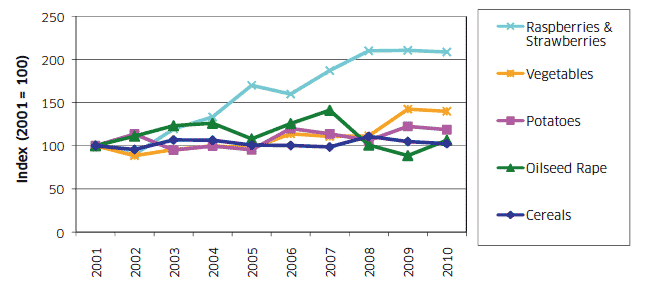
The most striking trend is the increase in fruit production of raspberries and strawberries, which have more than doubled over the past 10 years, increasing by 11,700 tonnes. This is mostly due to increases in the area and yields of strawberries.
The production of vegetables has increased over the past 10 years by 102,300 tonnes (40%), in particular the production of carrots has gone up by 83,000 tonnes (95%).
The production of potatoes increased by 259,000 tonnes (26%) between 2005 and 2006 and has generally remained higher compared to pre-2006 levels. The increase in 2006 was mostly due to very favourable growing and harvesting conditions, with very high yields accounting for most of the increase in production. Since 2006, a combination of good potato yields and increases in potato areas have contributed to higher production levels.
Over the past 10 years cereal production has ranged from 2.54 million tonnes in 2002 to 2.94 million tonnes in 2008. However, the 2010 harvest was just 66,000 tonnes (2.5%) higher than the 2001 harvest.
The production of oilseed rape, including that grown for industrial purposes on set-aside land, was 7,300 tonnes (6%) higher in 2010 compared to 2001. However, over the past 10 years production has varied reaching a peak of 161,300 tonnes in 2007, which was 39,700 tonnes (33%) higher than the 2010 harvest.
Cereals ( Table A3)
Chart A5 shows trends in the average annual output prices forcereals, used in the TIFF valuation. It is important to note that these calendar year prices span 2 crop production years and represent the value of cereals when they are used or sold off the farm. They also represent an average across different types of cereals used for animal feed, seed and human and industrial purposes. These prices, which are obtained from the HGCA (Home Grown Cereals Authority) incorporate tonnages sold on forward contracts as well as cereals sold at spot prices.
Table A3 shows the utilisation of cereals for different purposes. In 2010, the majority of wheat (72%) and oats (71%) was used for human and industrial purposes, whilst the majority of barley (65%) was used for animal feed.
Chart A5: Annual Average Output Prices for Cereals 2001 to 2010
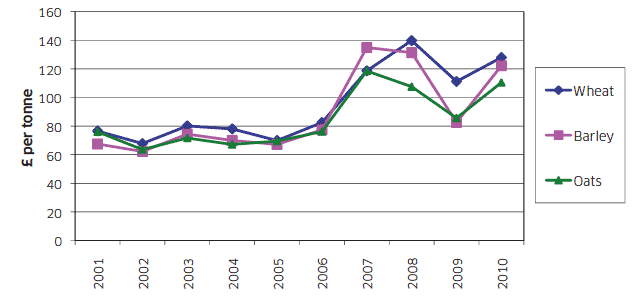
Cereal output prices were relatively stable between 2001 and 2006. In 2007, prices increased substantially, with barley showing the biggest increase from £77 per tonne to £135 per tonne (up 74%). This increase incorporates the price spike following the 2007 harvest, but the average for 2007 also incorporates output tonnages earlier in the calendar year from the 2006 harvest, which attracted much lower prices. The average output prices remained high in 2008, with wheat showing a further increase of £21 per tonne (18%). Average prices dropped quite markedly in 2009 before increasing again in 2010. These average prices reflect global trends in supply and demand of cereals.
In 2010, total value of cereal output increased by £81 million (32%), compared to 2009. The output value of barley increased by £44 million (28%), incorporating a £40 per tonne (48%) increase in price and a 240,000 tonne (13%) decrease in production. The output value of wheat increased by £33 million (40%), with average prices £17 per tonne (15%) higher and production also up by 171,000 tonnes (23%). The value of oats increased by £4 million (33%), mostly driven by an increase in price of £25 per tonne (29%).
Oilseed Rape ( Table A3)
Chart A6: Average Annual Output Price For Oilseed Rape 2001 to 2010
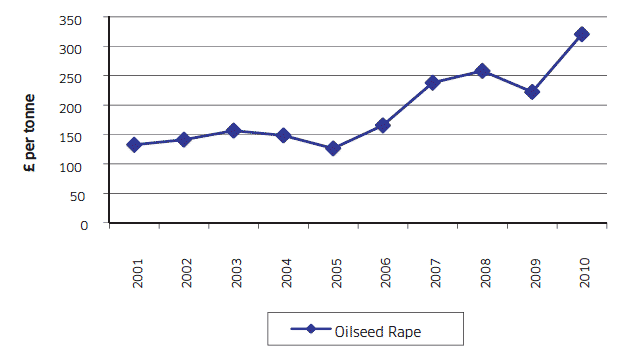
The average output price for oilseed rape increased sharply from £126 per tonne in 2005 to £321 per tonne in 2010. The increase between 2009 and 2010 of £98 per tonne (44%) was accompanied by an increase in production of 21,000 tonnes (20%), leading to an increase in the output value of £16 million (73%).
Potatoes ( Table A4)
Table A4 shows the components of the output valuation for potatoes. In 2010, maincrop ware potatoes accounted for 762,000 tonnes (53%) of output and seed potatoes 515,000 tonnes (35%).
Chart A7: Average Annual Output Prices For Potatoes 2001 to 2010
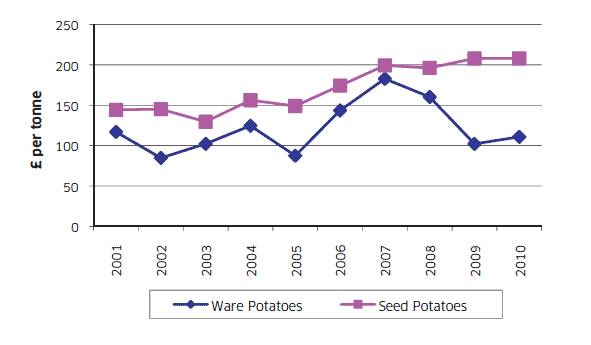
The price of ware potatoes was relatively high between 2006 and 2008, reaching a peak of £183 per tonne in 2007. In 2010 the price was £111 per tonne, more in line with other years in the period.
The price of seed potatoes has been increasing gradually from £149 per tonne in 2005 to £208 per tonne in 2010.
These price trends, especially for seed potatoes, coupled with increased production since 2006 have contributed to relatively high output value of potatoes since 2006.
In 2010, the overall output value of potatoes remained virtually unchanged at £186 million, with a small increase in price offsetting a small decrease in production.
Vegetables ( Table A4)
The valuation of vegetables is comprised of many different crops. Table A4 shows information for the key crops.
Over the past 10 years the output value of vegetables has increased by £49 million (86%) to £106 million in 2010.
Carrots have contributed the most to this increase, with a rise in output value of £15 million (143%). Over this period the increase in carrot production of 83,000 tonnes (95%) has been accompanied by an increase in price of £30 per tonne (25%).
In 2010, turnips and swedes were the 2nd largest crop in terms of production (61,000 tonnes or 17%) and value (£16 million or 15%). However, the 26% increase in price over the past 10 years was more than offset by a 35% decrease in production, leading to a decrease in value of £4 million (18%).
In 2010, the total output value of vegetables fell slightly by £3 million (3%).
Chart A8: Average Annual Output Prices for Carrots and Turnips and Swedes 2001 to 2010
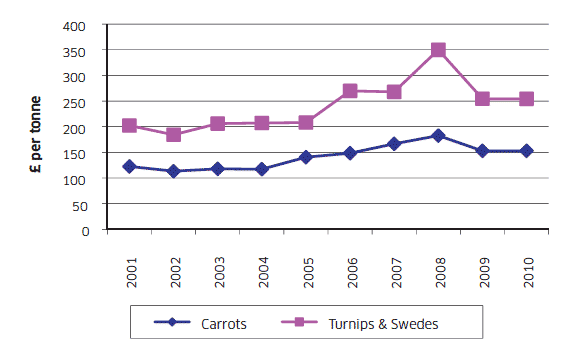
Soft Fruit ( Table A4)
Over the past 10 years the output value of soft fruit has increased by £38 million (150%) to £63 million in 2010.
Table A4 shows that in 2010, strawberries accounted for £44 million (70%) of the overall value and raspberries £13 million (21%).
Over the past 10 years the value of strawberries has increased by £27 million (156%). This was mostly due to an 11,000 tonne (146%) increase in production, as average prices only increased by £97 per tonne (4%).
The value of raspberries increased by £8 million (149%), mostly due to the doubling of average prices, which jumped dramatically in 2003. Production increased by 800 tonnes (25%) over this period.
In 2010, there was a decrease in the output value of soft fruit of £13 million (18%). Most of this decrease (£10 million) was due to strawberries, where prices fell by £471 per tonne (17%) and production also decreased by 400 tonnes (2%).
Chart A9: Average Annual Output Prices for Raspberries and Strawberries 2001 to 2010
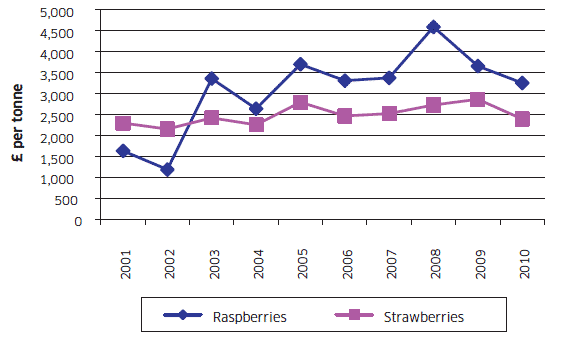
Since 2001 the total output value of finished and store livestock, excluding related subsidies, has increased by £335 million (58%) to £912 million in 2010.
The value of cattle has increased by £235 million (83%) over this period, with increases in every year except for 2007 and 2010.
Since 2001, the value of sheep has increased by £102 million, which also equates to 83%. However, most of this increase has occurred in last 2 years when the value increased by £68 million. Between 2001 and 2008 the value of sheep ranged between £122 million in 2001 and £157 million in 2004.
In comparison, the value of pigs and poultry has remained fairly constant over this period. The 2010 value of pigs was £3 million (4%) higher than 2001, whilst the 2010 value of poultry was £2 million (2%) lower than 2001.
In 2010, the output value of livestock increased by £18 million (2%), mostly due to the £17 million increase in sheep.
Chart A10: Output Value of Livestock (excluding subsidies) 2001 to 2010
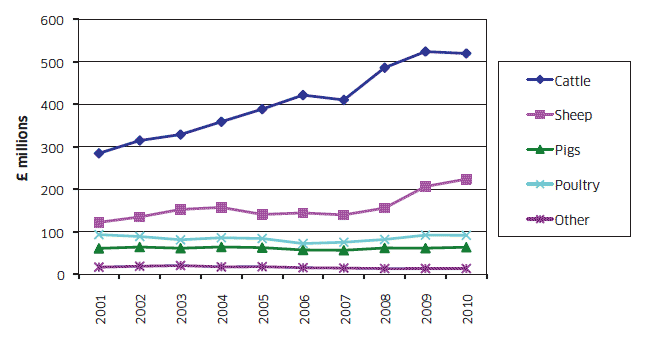
Tables A5 and A6 provide the detail behind these livestock valuations including numbers of livestock, weight of meat production, average output prices and stock change valuations.
In 2010, the output value of store cattle and calves was £47 million, representing 9% of the cattle total. The output value of store sheep was £25 million, representing 11% of the sheep total.
Chart A11: Output volume of Meat Production 2001 to 2010
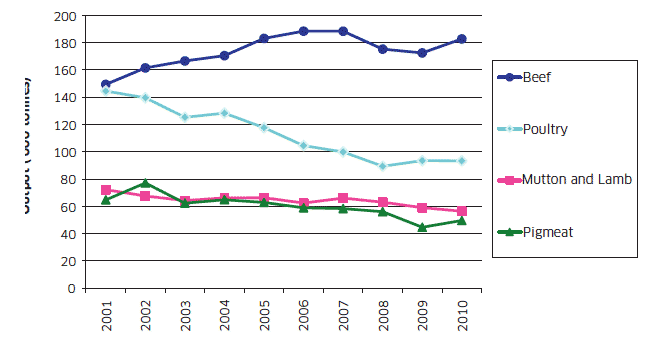
Over the past 10 years, only beef production has increased, going up by 33,000 tonnes (22%). Meat production has decreased for other livestock, with poultry meat showing the largest decrease of 51,000 tonnes (35%). The volume of mutton and lamb has gone down by 16,000 tonnes (22%) and pigmeat by a similar volume of 15,000 tonnes (23%).
Average output prices, expressed as £/kg dressed carcasse weight (dcw), have increased for all finished livestock since 2001.
Chart A12: Output prices of Finished Livestock 2001 to 2010
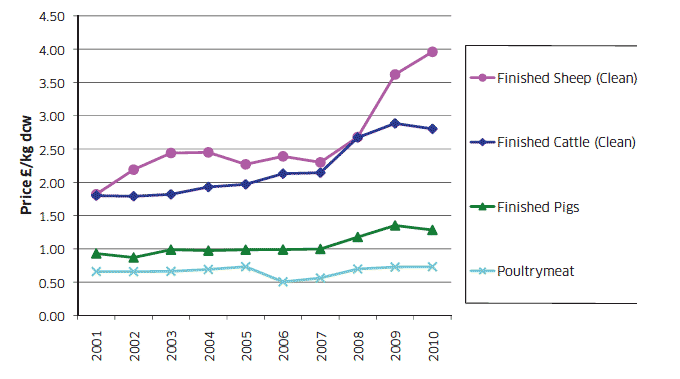
Over the past 10 years the average price for clean finished sheep has increased the most, going up by £2.14/kg (118%), with more than half of the increase taking place since 2008. This price trend has more than offset the reduction in mutton and lamb meat production and contributed to the increased value of sheep output.
Clean finished cattle prices have increased by £1.00/kg (56%) since 2001, with over half the increase (£0.56/kg) occurring between 2007 and 2008. This price trend, along with an increasing trend in beef production has contributed to the large increase in the value of cattle output. The average price fell slightly between 2009 and 2010 by £0.09/kg (3%) but was countered by an 8,000 tonne (5%) increase in beef production.
Over the past 10 years there have been similar increases in the price of finished pigs (£0.35/kg or 38%) and poultrymeat (£0.07/kg or 11%). These increases have been countered by similar decreases in meat production, resulting in small changes in the output value of pigs and poultry between 2001 and 2010.
Livestock Products (Tables A1, A6)
The output value of livestock products in 2010 was £323 million. The production of milk and milk products accounted for £272 million (84%) of this value and egg production £43 million (13%).
Over the past 10 years the output value of milk and milk products peaked in 2008 at £303 million, with the lowest value of £215 million in 2002. Following a decrease between 2008 and 2009, the value has fallen very slightly in 2010. Compared to 2001, the 2010 value is £27 million (11%) higher.
The value of egg production for food has increased by £17 million (66%) over the past 10 years, with much of the increase (£11 million) occurring between 2007 and 2008.
Chart A13: Output Value of Livestock Products 2001 to 2010
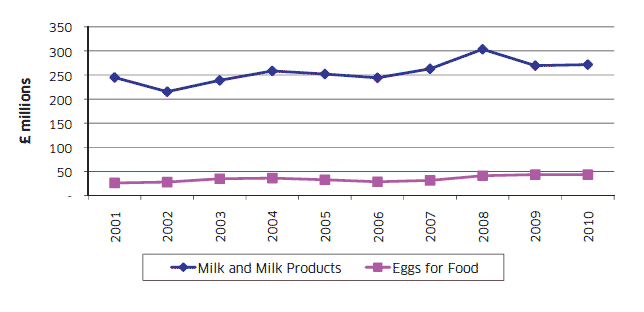
Table A6 includes information on the production and average prices for milk (including milk products). Both prices and production were fairly constant between 2003 and 2006, resulting in little change in the output value. Production then fell by 210 million litres (16%) between 2006 and 2008, but was accompanied by an increase in price of 8.5 per litre (47%), resulting in an overall increase in the output value of £59 million (24%). Over the past 2 years, prices have fallen by 8% and production is also 2% lower, resulting in a £32 million (11%) decrease in the value.
Chart A14 Milk (including milk products) Production and Average Price 2001 to 2010
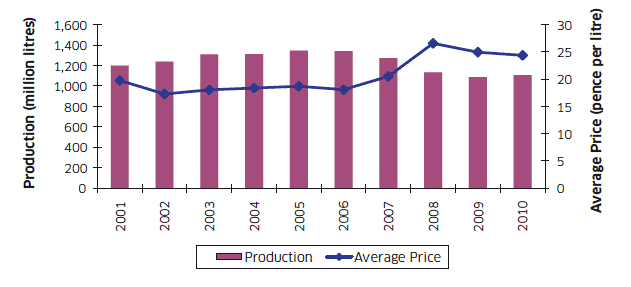
Total Costs ( Table A1)
In 2010, total costs incurred by agricultural businesses was £2.4 billion. These costs are made up of many different components.
Chart A15: Total Costs 2001 to 2010
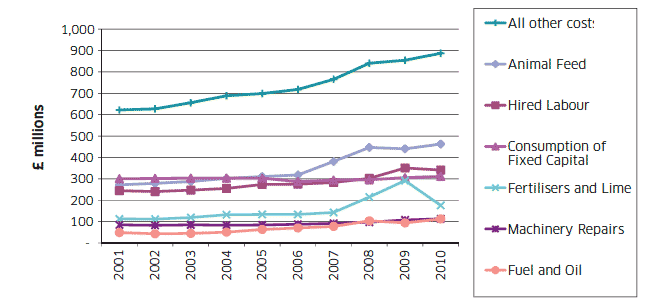
In 2010, the largest costs were for: animal feed (£463 million or 19% of the total); hired labour (£341 million or 14%); consumption of fixed capital (£312 million or 13%), mainly on plant machinery, vehicles, buildings and works; fertilisers and lime (£176 million or 7%); machinery repairs (£113 million or 5%) and fuel and oil (£112 million or 5%). All other costs, totalling £887 million accounted for 37% of the total.
Over the past 10 years, total costs have increased by £718 million (43%) to £2.4 billion in 2010, with most of the increase (£514 million) occurring since 2006. Since 2001, the largest increases have occurred in animal feed (up £191 million or 70%), hired labour (up £96 million or 39%), fuel and oil (up £64 million or 130%) and fertiliser and lime (up £63 million or 56%). The only decreases, at the aggregate level shown in table A1 have been for interest payments (down £24 million or 26%), net rent (down £2 million or 13%) and in the leasing of quotas (down £4 million or 100%).
Between 2009 and 2010, total costs decreased by £41 million (2%), contributing to the overall increase in TIFF. This was mostly due to the costs of fertiliser and lime falling by £116 million (40%), from the peak in 2009, although hired labour costs also decreased by £10 million (3%). These decreases more than offset other increases in costs, including those for animal feed (up £22 million or 5%), fuel and oil (up £18 million or 20%) and veterinary expenses and medicines (up £8 million or 15%).
Most of the animal feed costs are associated with the purchase of concentrate feed, especially for cattle and sheep. Over the past 10 years, increasing trends in these concentrate feeds have contributed the most to the overall increase in animal feed costs. However, between 2009 and 2010, the cost in cattle and sheep concentrate feeds are estimated to have fallen slightly, based on lower prices shown in the DEFRA Agricultural Price Index.
In the last year, the main reason for the £22 million increase in animal feed costs has been a £14 million (19%) increase in the cost of cereals, mostly barley, used directly as animal feed on farm and a £10 million (23%) increase in the cost of roughages such as hay and straw. These both reflect increased prices, with average annual prices for roughages shown in Table A7. Severe weather at the beginning and end of 2010 led to a higher demand for roughages, driving up market prices.
Fertiliser and Lime (Table A1, A8)
There has been substantial variation in the cost of fertilisers and lime over the past 4 years, as shown in Chart A15, which has had a considerable impact on recent trends in TIFF. Table A8 shows key components of the underlying price and quantity information used in the compilation of the fertiliser and lime valuation.
It should be noted that the vast majority of fertilisers are used in the first half of the calendar year. However, a substantial proportion of these fertilisers will have been purchased in the previous autumn/winter. This lag between purchases and usage has been accounted for in the TIFF valuation and should be borne in mind when comparing average annual prices in TIFF with monthly market prices.
Chart A16 shows a summary of fertiliser usage and average annual prices, expressed in terms of nutrient tonnes. Nutrient tonnes are used in order to account for different types of fertilisers which have different compositions in terms of nutrient content.
There has been a decreasing trend in the usage of fertilisers between 2001 and 2008. Although total usage is shown to have increased between 2008 and 2009, this does reflect a break in the data series, as administrative data from the Single Farm Payments ( SFP) systems was used as the source of land use data. The SFP data showed higher areas of grassland, to which fertilisers are applied, compared to previous June Census information.
Compared to 2001, the quantity of fertiliser usage in 2010 was 92,000 tonnes (25%) lower, however the average price was £289 per tonne (105%) higher. Over this period average prices started to increase in 2004, accelerating to a peak of £969 per tonne in 2009. In 2010, prices fell sharply by £405 per tonne (42%) accounting for all of the £116 million decrease in the costs of fertilisers and lime.
Chart A16: Quantity & Average Annual Prices of Fertilisers Used 2001 to 2010
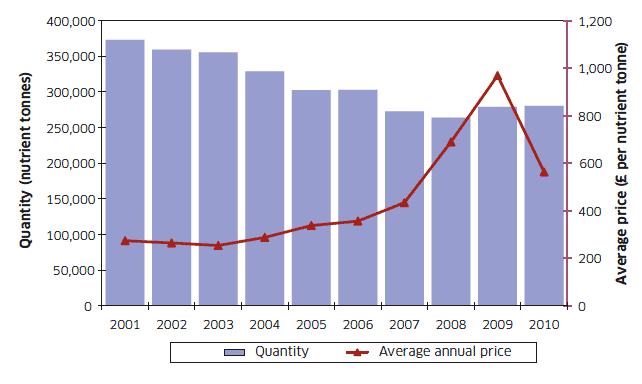
Red diesel is used as fuel by agricultural businesses. Red diesel is cheaper than conventional diesel, as it attracts lower rates of tax. The overall trend in red diesel prices have shown a steady increase since 2002, with a spike in prices during 2008. This reflects broader global trends in fuel prices.
In 2010, the overall cost of fuel and oil increased by £18 million (20%), reflecting the 9.4 pence per litre (21%) increase in red diesel prices.
Chart A17: UK Red Diesel Annual Average Prices 2001 to 2010
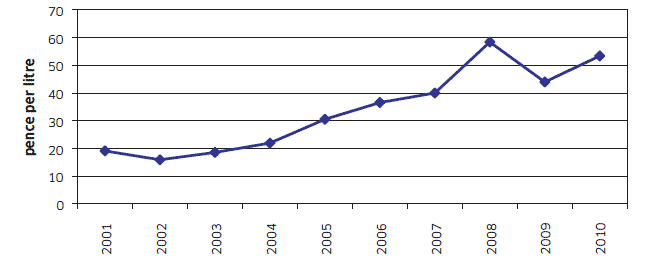
Hired labour costs increased by £106 million (43%) between 2001 and 2009, before falling by £10 million (3%) in 2010. These costs are calculated by taking into account the number of hired workers reported in the June Agricultural Census and information on earnings from the monthly Survey of Hours and Earnings of Agricultural Workers.
Between 2001 and 2009 there has been a gradual decline in the number of hired regular workers but an increase in the number of casual and seasonal workers, particularly since 2006. However, between 2009 and 2010 these trends reversed, with a 6% increase in regular workers and a 12% decrease in casual and seasonal workers. It is this decrease in casual and seasonal workers which has contributed most to the lower hired labour costs in 2010.
Table A10 shows survey results for regular full-time hired workers. Since 2006, average weekly earnings have increased, although the average number of hours worked has gone down and the rate of earnings per hour has increases. Over the past 10 years, the hourly rate of pay has generally increased, but there has been more variation in the average number of hours worked.
Interest Payments (Table A1, A11)
Over the past 10 years there has been a steady increase in the outstanding balance of farm borrowing, from £1.2 billion in 2001 to £1.5 billion in 2010. Over the same period, the corresponding level of interest payments has varied, reflecting changes in underlying interest rates.
Recently, there was a large fall in interest payments between 2008 and 2009 of £44 million (38%) and interest payments remained relatively low in 2010, falling by a further £3 million (4%).
Chart A18: Outstanding Balance of Farm Borrowing & Interest Payments 2001 to 2010
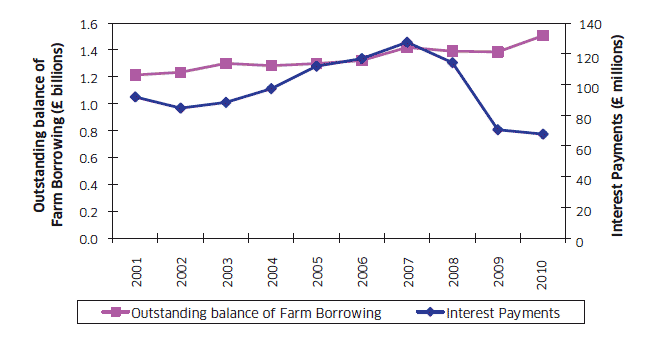
Statistics on the level of farm borrowing are published in August each year, with the latest release from 2010 available at: http://www.scotland.gov.uk/Topics/Statistics/Browse/Agriculture-Fisheries/pubfarmborr
Payments and Subsidies (Tables A12(i), A12(ii))
In 2010, total payments and subsidies included in the TIFF figure were £616 million. Table A12(i) provides a breakdown of this total, with Single Farm Payments at £484 million accounting for the majority (79%), followed by Less-Favoured Area Support Scheme ( LFASS) payments at £64 million (10%). The next largest amounts were for payments under Rural Priorities (£21 million or 3%) and the Scottish Beef Calf Scheme (£19.2 million or 3%).
Not all payments and subsidies made to farmers are included in the TIFF total. Table A12(ii) shows a further £27 million paid to farmers in 2010, mostly under Rural Priorities (£17 million) and the FEOGA Processing and Marketing Scheme (£7 million). These payments were primarily for capital improvements and for non-agricultural activities, which fall outwith the scope of the TIFF definition.
It should be noted that the totals under various schemes shown in Tables A12(i) and A12(ii) only represent payments made to the agriculture sector, so exclude any payments to other sectors such as forestry. They also exclude broader non-agricultural payments under the Scottish Rural Development Programme.
Chart A19 illustrates trends in payments and subsidies included within the TIFF total for the past 10 years. In 2005, de-coupling of payments and subsidies took place under reforms of the Common Agricultural Policy ( CAP). Payments previously tied directly to crop and livestock production were mostly consolidated into the Single Farm Payment. Since 2005, cattle subsides have included payments under the Scottish Beef Calf Scheme, ranging between £18 million and £24 million. There were also payments under the 'Over 30 Month Scheme' (up to 2006) and 'Older Cattle Disposal Scheme' (up to 2008), related to the disposal of older cattle which were prevented from entering the food chain, in order to minimise the risk to public health related to BSE.
Chart A19: Payments and Subsidies & TIFF 2001 to 2010
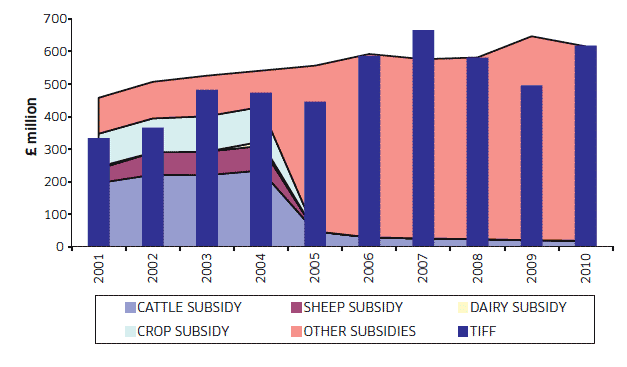
Total payments and subsidies included in TIFF have increased by £158 million (34%) between 2001 and 2010. However, this includes a decrease between 2009 and 2010 of £28 million (4%), mostly due to a fall in the value of Single Farm Payments ( SFP) of £28 million (6%). This decrease is due to a less favourable euro:sterling exchange rate on 30th September 2010 compared to the previous year, which is when sterling payments of Single Farm Payments are calculated.
It should be noted that the 2010 total includes £2.6 million paid out from the EU Dairy Fund as well as £200,000 of Severe Weather Payments.
Chart A19 also shows that with the exception of 2007, the total value of TIFF has been about equal or lower than the value of total payments and subsidies. This means that without these payments and subsidies, the aggregate income to farmers would have been negative in those years.
Balance Sheets and Investments (Tables A13, A14)
Over the period 2001 to 2010 the net worth of Scottish agriculture has nearly tripled from £11.7 billion to £34.2 billion. This is primarily because of a large rise in the value of land and buildings over that period, which has more than tripled from £10.5 billion in 2001 to £32.3 billion in 2010; although most of this rise has occurred in years from 2007 to 2010. From 2009 to 2010 alone, the value of land and buildings rose £2.7 billion (9.1 per cent). Land values information is based on land prices from the Value Office Agency which has been supplemented with data from the Royal Institution of Chartered Surveyors ( RICS) for 2009 and 2010.
The liabilities of Scottish agriculture have risen 33 per cent between 2001 and 2010 to just £2.2 billion, representing 6 per cent of total asset value. Between 2009 and 2010 the value of liabilities fell slightly by £60 million but this has virtually no impact on the overall net worth of Scottish agriculture.
The amount farmers invested in buildings, plant, machinery and vehicles rose £53.1 million (22 per cent) from 2009 to 2010 and is nearly 40 per cent above the average for the last ten years.
Economic Indicators and Productivity (Tables A15, A16)
Table A15 provides information on a range of economic indicators related to Total Income From Farming ( TIFF).
One measure considers the return to farmers, partners, directors and others with an entrepreneurial interest in the farm business, against the labour they themselves have invested in the business.
This is done by estimating the amount of entrepreneurial labour invested, expressed in terms of full time equivalent, annual work units ( AWU). TIFF is then divided by this total to provide TIFF per AWU.
Table A15 shows that in 2010, the total amount of entrepreneurial labour invested was 27,364 AWU. Dividing the TIFF figure of £618 million by this labour, provides an average TIFF per AWU estimate of £22,590.
Chart A20 shows that between 2001 and 2010 entrepreneurial labour decreased by 10% or 3,009 AWUs and TIFF per AWU increased by £11,595 (105%). This increase in TIFF per AWU mostly reflects the £284 million (85%) increase in TIFF over the same period, as well as the 10% decrease in entrepreneurial AWUs. It means that in 2010 a larger TIFF was being generated by a lower amount of entrepreneurial labour, compared to 2001.
Chart A20: Entrepreneurial Labour and TIFF per AWUs 2001 to 2010
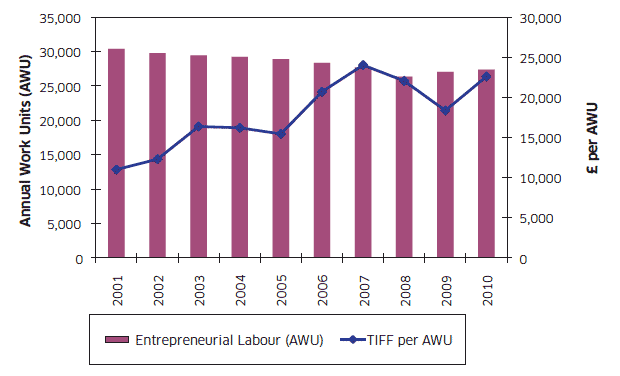
Table A16 shows three different productivity indices, which are based on differing definitions with respect to component inputs and outputs.
All three measures show a higher productivity in 2010 compared to 2001, but also lower productivity in 2010 compared to 2009. The decrease between 2009 and 2010 is primarily (but not exclusively) due to (i) a reduction in Single Farm Payment and (ii) an increase in the amount of paid labour.
There is a problem
Thanks for your feedback